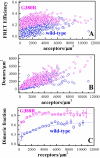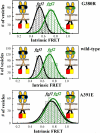Effect of the achondroplasia mutation on FGFR3 dimerization and FGFR3 structural response to fgf1 and fgf2: A quantitative FRET study in osmotically derived plasma membrane vesicles
- PMID: 27040652
- PMCID: PMC4870120
- DOI: 10.1016/j.bbamem.2016.03.027
Effect of the achondroplasia mutation on FGFR3 dimerization and FGFR3 structural response to fgf1 and fgf2: A quantitative FRET study in osmotically derived plasma membrane vesicles
Abstract
The G380R mutation in the transmembrane domain of FGFR3 is a germline mutation responsible for most cases of Achondroplasia, a common form of human dwarfism. Here we use quantitative Fӧster Resonance Energy Transfer (FRET) and osmotically derived plasma membrane vesicles to study the effect of the achondroplasia mutation on the early stages of FGFR3 signaling in response to the ligands fgf1 and fgf2. Using a methodology that allows us to capture structural changes on the cytoplasmic side of the membrane in response to ligand binding to the extracellular domain of FGFR3, we observe no measurable effects of the G380R mutation on FGFR3 ligand-bound dimer configurations. Instead, the most notable effect of the achondroplasia mutation is increased propensity for FGFR3 dimerization in the absence of ligand. This work reveals new information about the molecular events that underlie the achondroplasia phenotype, and highlights differences in FGFR3 activation due to different single amino-acid pathogenic mutations.
Keywords: Achondroplasia; Dimer stability; Dimerization; Fibroblast growth factor receptor 3; Receptor tyrosine kinases; skeletal disorders.
Copyright © 2016 Elsevier B.V. All rights reserved.
Figures




Similar articles
-
Direct assessment of the effect of the Gly380Arg achondroplasia mutation on FGFR3 dimerization using quantitative imaging FRET.PLoS One. 2012;7(10):e46678. doi: 10.1371/journal.pone.0046678. Epub 2012 Oct 9. PLoS One. 2012. PMID: 23056398 Free PMC article.
-
Characterization of membrane protein interactions in plasma membrane derived vesicles with quantitative imaging Förster resonance energy transfer.Acc Chem Res. 2015 Aug 18;48(8):2262-9. doi: 10.1021/acs.accounts.5b00238. Epub 2015 Aug 5. Acc Chem Res. 2015. PMID: 26244699 Free PMC article.
-
Physical basis behind achondroplasia, the most common form of human dwarfism.J Biol Chem. 2010 Sep 24;285(39):30103-14. doi: 10.1074/jbc.M109.094086. Epub 2010 Jul 12. J Biol Chem. 2010. PMID: 20624921 Free PMC article.
-
[Cytokines in bone diseases. FGF receptor signaling and achondroplasia/hypochondroplasia].Clin Calcium. 2010 Oct;20(10):1490-6. Clin Calcium. 2010. PMID: 20890030 Review. Japanese.
-
Mutations of the fibroblast growth factor receptor-3 gene in achondroplasia.Horm Res. 1996;45(1-2):108-10. doi: 10.1159/000184768. Horm Res. 1996. PMID: 8742128 Review.
Cited by
-
The Biased Ligands NGF and NT-3 Differentially Stabilize Trk-A Dimers.Biophys J. 2021 Jan 5;120(1):55-63. doi: 10.1016/j.bpj.2020.11.2262. Epub 2020 Dec 5. Biophys J. 2021. PMID: 33285113 Free PMC article.
-
Neural network strategies for plasma membrane selection in fluorescence microscopy images.Biophys J. 2021 Jun 15;120(12):2374-2385. doi: 10.1016/j.bpj.2021.04.030. Epub 2021 May 4. Biophys J. 2021. PMID: 33961865 Free PMC article.
-
Transmembrane helix interactions regulate oligomerization of the receptor tyrosine kinase EphA2.J Biol Chem. 2024 Jul;300(7):107441. doi: 10.1016/j.jbc.2024.107441. Epub 2024 Jun 3. J Biol Chem. 2024. PMID: 38838777 Free PMC article.
-
The Effect of Transmembrane Protein Shape on Surrounding Lipid Domain Formation by Wetting.Biomolecules. 2019 Nov 12;9(11):729. doi: 10.3390/biom9110729. Biomolecules. 2019. PMID: 31726783 Free PMC article.
-
Probing Membrane Protein Association Using Concentration-Dependent Number and Brightness.Angew Chem Int Ed Engl. 2021 Mar 15;60(12):6503-6508. doi: 10.1002/anie.202010049. Epub 2021 Feb 4. Angew Chem Int Ed Engl. 2021. PMID: 33351993 Free PMC article.
References
-
- Horton WA, Hall JG, Hecht JT. Achondroplasia. Lancet. 2007;370:162–172. - PubMed
-
- Shiang R, Thompson LM, Zhu Y-Z, Church DM, Fielder TJ, Bocian M, Winokur ST, Wasmuth JJ. Mutations in the transmembrane domain of FGFR3 cause the most common genetic form of dwarfism, achondroplasia. Cell. 1994;78:335–342. - PubMed
-
- Deng C, Wynshaw-Boris A, Zhou F, Kuo A, Leder P. Fibroblast growth factor receptor 3 is a negative regulator of bone growth. Cell. 1996;84:911–921. - PubMed
-
- Cohen MM. Some chondrodysplasias with short limbs: molecular perspectives. Am. J. Med. Genet. 2002;112:304–313. - PubMed
Publication types
MeSH terms
Substances
Grants and funding
LinkOut - more resources
Full Text Sources
Other Literature Sources

